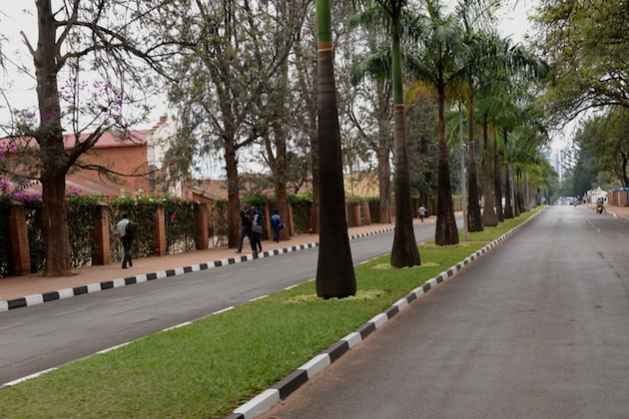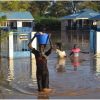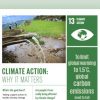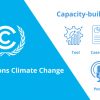[ad_1]
Creator and Web page data
- This web page: https://www.globalissues.org/article/797/cop17-durban-climate-conference.
- To print all data (e.g. expanded facet notes, exhibits various hyperlinks), use the print model:
On this web page:
Introduction
 November 28 – December 9, 2011, Durban, South Africa was the venue for the seventeenth annual United Nations Local weather Change Convention, also referred to as the seventeenth Convention of the Events — or COP 17.
November 28 – December 9, 2011, Durban, South Africa was the venue for the seventeenth annual United Nations Local weather Change Convention, also referred to as the seventeenth Convention of the Events — or COP 17.
Predictably and sadly, the identical points complained about at earlier annual conferences for the previous decade proceed to recycle themselves:
- Lack of high quality (if any) media protection
- West stalling on doing something attempting responsible India and China as an alternative
- Lack of funding
- Disagreement on tips on how to handle it
- and so on.
Because the previous twenty years have proven attempting to get world settlement on tackling local weather change appears to be futile. By comparability, extra targeted and restricted curiosity of elites, nonetheless, are simpler to push via, reminiscent of wars based mostly on geopolitical threats (actual and imaginary), or financial crises (the place banks and different elites most chargeable for the crises are bailed out by atypical residents).
Moreover, because the West has typically proven up to now decade or extra (even when their economies have been doing good) paying now for one thing that appears to be an issue sooner or later is difficult to simply accept. It’s simpler, subsequently, to stall and maintain blaming China, India and different rising nations regardless of the historic inequality of these emissions. However ignoring that makes it simpler to hope these rising nations will choose up the burden of addressing emissions rises.
Typically talking, media protection of local weather change points and these conferences has been a combined bag over the previous decade. Newer years has seen elevated curiosity and protection (although many vital points are glossed over in mainstream media sound-byte model reporting).
Nevertheless, by comparability, this yr’s mainstream media protection of this important convention was near pathetic, to place it politely. In actuality cash speaks and so brief time period and elite/institution views are inclined to prevail, which is why governments can so shortly get the 99%
to bail out the banks and the highest 1% with many trillions of {dollars}, whereas discovering billions for preventing much more devastating local weather change has taken virtually 2 a long time thus far with none convincing outcomes.
Personally observing mainstream TV information in UK through the week of the Durban talks revealed virtually no main headlines till the final day and even then only a few moments of summarizing a complete two weeks, which in fact just isn’t sufficient. However my very own observations weren’t systemmatic. Nevertheless, media watchdog Media Lens confirmed my fears of poor protection, not simply within the UK however elsewhere such because the US:
Media curiosity within the topic has crashed. Dr. Robert J. Brulle of Drexel College describes a
collapse of any vital protection of local weather change within the [US] media. We all know that 2010 was a document low yr, and 2011 will most likely look a lot the identical. If the media does not draw consideration to the difficulty, public opinion will decline.…
Equally disturbing is the variation in media efficiency throughout the globe. A large-ranging Reuters research on the prevalence of local weather skepticism on the planet’s media — Poles Aside — The worldwide reporting of local weather skepticism – targeted on newspapers in Brazil, China, France, India, the UK and the USA. The durations studied have been February to April 2007 and mid-November 2009 to mid-February 2010 (a interval that included the UN local weather change summit in Copenhagen and
Climategate). Remarkably, the research concluded that local weather skepticism ispredominantly an Anglo-Saxon phenomenon, discovered most often in US and British newspapers.…
And so we discover that Britain and the US — the 2 nations responding most aggressively to alleged
threatsto human safety in nations like Afghanistan, Iraq and Libya — are additionally the 2 nations least inquisitive about responding to the very actual menace of local weather change.
Local weather Disaster – The Collapse In Company Media Protection
, Media Lens, December 1, 2011
A further concern that Media Lens additionally raises is what they described as capitalism trampling on journalism
:
A primary instance of this trampling was equipped by the high-profile BBC collection Frozen Planet, narrated by David Attenborough, specializing in life and the setting within the Arctic and Antarctic. British viewers will see a complete of seven episodes, the final of which,
On skinny ice, offers with the specter of local weather change.Nevertheless, viewers in another nations will solely watch six episodes. It’s because the BBC packaged the collection in such a means that the local weather change episode was an
elective additionalthat overseas networks might select to reject. And reject it they did — of 30 networks the world over which have purchased the collection, 10 have opted to not purchase the episode on local weather change. Most notable amongst them is the USA, the world’s main contributor each to local weather disaster and disinformation about the issue.
Local weather Disaster – The Collapse In Company Media Protection
, Media Lens, December 1, 2011
In the USA, the annual Tyndall Report, which displays the each day nightly newscasts of the three essential TV shops (ABC, CBS, and NBC) discovered simply 4 tales on local weather change for the whole 2011 on the three prime time information exhibits, two of them being simply over 2 minutes every (the opposite two I can not entry from overseas).
The precise exhibits monitored are in fact not the one information proven within the evenings, and different shops like CNN should not included, and neither is the Web, however 2/3rds of individuals get their information from TV within the US, as Jim Lobe famous in a information story protecting this yr’s Tyndall report. In that story, Andrew Tyndall, was interviewed by Jim Lobe who additionally added:
It’s secure to say that the community information is complicit on this nation’s [the USA] world warming denialism, reinforcing the issue, versus reporting on it.
Arab SpringDominated TV International Information in 2011, Inter Press Service, January 2, 2012
And whereas it appears unimportant to the mainstream media, nature continues its course:
Whereas public concern grows and media protection collapses, the local weather change drawback goes via the roof. In accordance with a current research by the US Division of Vitality, the worldwide output of heat-trapping carbon dioxide jumped by the largest quantity on document in 2010. The world pumped about 564 million extra tons of carbon into the air in 2010 than it did in 2009, a rise of 6 per cent. The newest figures imply that ranges of greenhouse gases
are larger than the worst case situation outlined by local weather consultants simply 4 years in the past, USA Right now stories.…
Within the US alone, roughly $3.5 bn is invested yearly in lobbying actions on the federal stage. In recent times, Royal Dutch Shell, the US Chamber of Commerce, Edison Electrical Institute, PG&E, Southern Firm, ExxonMobil, Chevron, BP and ConocoPhillips all made the highest 20 record of lobbyists. The local weather marketing campaign organisation 350.org estimates that 94 per cent of US Chamber of Commerce contributions went to local weather denier candidates.
Local weather Disaster – The Collapse In Company Media Protection
, Media Lens, December 1, 2011
And these are rises of carbon emissions even through the robust financial circumstances.
Media Lens and USA Right now are referring to the world carbon undertaking report.
That report provides that though China, USA, India, and Russia accounted for the biggest emissions development in 2010, Per capita emissions of developed nations stay a number of instances bigger than these of creating nations.
In different phrases, vital — and fairer — good points could be obtained if wealthy nations would sort out their emissions (as has repeatedly been identified for some 2 a long time).
Reuters summarized the above report and in addition added {that a} separate research revealed not too long ago concluded there was virtually no likelihood of limiting warming to 2 levels Celsius based mostly on big investments in polluting energy stations.
The abstract of that report from the journal, Nature Local weather Change, worries: How nations intend to maintain inside a 2 °C threshold, not to mention contemplate at [sic] 1.5 °C threshold, is unclear in gentle of present progress
(or lack of).
Regardless of Europe being heading in the right direction to fulfill its Kyoto commitments, world carbon dioxide emissions are nonetheless on the rise having spiked by 45% since 1990 to achieve a document stage of 33 billion tonnes final yr.
… to remain beneath 2 °C all through this century, annual emissions should come down by about 4 billion tonnes of carbon dioxide equal from the current day stage to about 44 Gt of carbon dioxide equal in 2020. Even then, there may be only a 66% chance of staying inside the 2 °C threshold by 2100. Out of the practically 200 eventualities studied, solely three give a 90% chance of staying beneath 2 °C this century, and all of these depend on commercially unproven applied sciences to seize and retailer carbon-based greenhouse gases. Even with using these applied sciences, there may be at finest a 50% chance of staying beneath 1.5 °C this century. Worryingly, if we wait till 2030 for emissions to peak, we’re extra more likely to be seeking to keep away from 3 °C this century than 2 °C. In brief, the two °C threshold is steadily slipping of attain, and 1.5 °C already appears unachievable.
Holding the common temperature improve inside 2 °C of pre-industrial ranges implies a goal of 450 components per million (ppm) C02 within the ambiance. However 450ppm is already feared as not a secure goal, however the one sensible one to intention for now due to lack of progress amongst industrialized nations up to now 2 a long time. And what if we get to 451 ppm?
How a lot will the world change if we improve CO2 ranges to 451 ppm? Time will inform, however by some means we could also be duplicating in power in simply 200 years what nature itself requires 10,000 years to do. We’re making use of that forcing past the purpose at which nature has at all times stopped.
We’re duplicating inside that brief time interval the best single power on this planet that nature alone has wielded for the previous 2.5 million years. However nature does so slowly, rigorously and predictably.
We’re doing so quickly, erratically, and with out consciousness or understanding of the results, and even taking lengthy sufficient to acknowledge that what we’re doing does certainly have an irreversible impact.
Widespread however Differentiated Duty Precept Sidelined Once more
As Inter Press Service (IPS) summarized:
What’s abundantly clear is the large divide between the wealthy and poor nations. Poor nations need deep cuts in emissions by the industrialized world, and the latter proceed to withstand vital cuts and legally binding targets.
This web site’s part on local weather justice has lengthy gone into some element about
- How the
Widespread however Differentiated Duty
acknowledges that wealthy nations have emitted a lot of the greenhouse gases which can be inflicting local weather change, that creating nations’ emissions are more likely to rise on their path to industrialization and attempting to fulfill primary social and improvement wants; and that subsequently whereas the targets are the identical, the means to sort out local weather change can be completely different. - Yr after yr at local weather summits, it appears this precept is usually ignored by some wealthy nations and their media.
- It has subsequently been simpler in public responsible nations like China and India for reacting negatively and being uncooperative when confronted with strain to undergo emission discount targets (earlier than many wealthy nations show they’ll do the identical).
Greenhouse gases have a tendency to stay within the ambiance for a lot of a long time so historic emissions are an vital consideration.
The next exhibits that the wealthy nations (generally known as Annex I nations
in UN local weather change communicate) have traditionally emitted greater than the remainder of the world mixed, regardless that China, India and others have been rising not too long ago. That is why the frequent however differentiated duties
precept was acknowledged.
(Chart up to date in January 2012 so as to add information as much as 2008 and preliminary estimates for 2009 and 2010)

Little doubt, creating nations ought to pay attention to their current rise and in addition do extra to curb their emissions. However given their later entry to industrialization and that their per capita emissions are even lower than wealthy nations, extra emission discount is also achieved per individual in wealthy nations.

The US and others have characterised the marketing campaign for local weather justice and equality to the ambiance as a technique to declare local weather reparations
; that it’s unfair to make the industrialized nations pay for local weather emissions into the previous century or extra at a time once they didn’t know it could trigger extra hurt.
That appears affordable. Nevertheless, one of many implications is that any settlement that’s subsequently drawn up will, in impact, put disproportionately extra burden on the poorer nations to sort out an issue they didn’t largely trigger. The poor are much less more likely to have the assets to take action, which additionally signifies that tackling local weather change is much less possible to achieve success.
That is why wealthy nations are being requested to significantly take into consideration the sort and means they use vitality along with serving to the poorer nations (not essentially reparations
however via significant expertise and adaptation help — which might be far more cost effective than the bailouts readily handed to those who did trigger a serious drawback).
As well as, there may be little equity in asking China, India and others to be topic to emission targets when many wealthy nations didn’t obtain the watered down Kyoto targets themselves.
Some rising nations are in a gray space — India, China, Brazil, and so on are quickly creating and though they’ve monumental social and improvement issues excellent, a few of their rich are as rich (some extra so) as these in industrialized nations. As such, wealthier creating nations aren’t essentially the goal (nor asking) for such adaptation funds.
It’s definitely extra advanced than a number of sentences on this web page can present, however the simplification provided by wealthy nation leaders and their media hides this complexity yr after yr. (See local weather justice from this website for extra particulars on this.)
Durban assembly end result
The assembly in Durban appeared fairly intense; some such because the US and EU have been eager on getting China, India and different massive rising nations to signal on to binding emission discount agreements. These nations have been understandably reluctant and even when they could be gaining a stronger voice within the wake of the worldwide/Western monetary disaster, this assembly additionally confirmed that they haven’t eclipsed the West (a minimum of not but) on the diplomatic entrance.
Stephen Leahy, writing for IPS, supplies a helpful abstract of the Durban assembly:
The world is more and more dedicated to harmful ranges of world warming with one more failure by nations of the world to comply with wanted reductions in carbon emissions right here in Durban.
…
After two weeks and an extra 29 hours of intense and even bitter negotiations, the 193 nations collaborating within the United Nations local weather talks agreed to a fancy and technical set of paperwork known as the
Durban Platform.These embody the continuation of the Kyoto Protocol, a proper construction for a Inexperienced Local weather Fund, new market mechanisms, and extra.…
At the moment the promised emission reductions by industrialised nations and people of China, Brazil, South Africa, India and others underneath the 2009 Copenhagen Accord assure a world that’s a minimum of 3.5 levels Celsius hotter on common in line with local weather science. It is going to be double that over massive components of the world. Some evaluation says this world common may very well be even larger rising to 4 or 5 levels Celsius threatening our species with annihilation.
Curiously, the extent of discount promised by the industrialized world is small in comparison with its portion of emissions. And it seems to be as if creating nations have misplaced out in some ways:
Regardless of the political posturing by the USA, Canada and even the European Union, the actual fact is that creating nations’ promised reductions are larger than the industrialised world which can be chargeable for 75 p.c of the overall human emissions within the ambiance.
…
Ready till 2020 to make main cuts means these cuts should be far deeper and way more expensive to have any hope of retaining temperatures beneath two levels Celsius,
…
The
Durban Platformfeatures a second dedication interval of the Kyoto Protocol that can start January 2013, avoiding a spot on the finish of the primary dedication interval ending subsequent yr. The size of the second dedication interval is to be determined at COP 18 in Qatar.Creating nations insisted on this situation as a result of Kyoto is the one legally binding emissions discount settlement. Nevertheless, it solely requested for small reductions from industrialised nations like these in Europe, Canada, Australia, Japan and some others. The U.S. opted out and Canada ignored its obligations and elevated emissions 24 p.c. And now Canada, Japan and Russia have stated they’ll take not participate within the second dedication interval.
However it isn’t simply creating nations which have misplaced out; nearly all of the primary world could have misplaced out too. As a result of, as Stephen Leahy rightly notes, trillions are simply and shortly made out there to bail out the elite in a monetary crises. However on the subject of a fair greater disaster that’s additional away (and admittedly more durable, maybe, to internalize), funds out of the blue appear laborious to search out; governments are out of the blue cash-strapped.
Personal sources explicitly embody carbon markets as governments from the wealthy nations often cited the monetary disaster has tied their purse strings. Civil society and a few creating nations famous that governments have made trillions of {dollars} out there for the financial institution and monetary sector and that world’s army finances is greater than 10 instances what is required for the GFC [Green Climate Fund].
See additionally George Monbiot’s be aware on this, evaluating the $7 trillion in US bailout for their very own banks, whereas an estimate for capping local weather change globally would require lower than a tenth of that: $650 billion. And distinction how shortly the trillions have been made out there versus how difficult it’s for a local weather fund to return about.
The opposite vital concern for creating nations is that any local weather fund be impartial of Western management, by some means, due to the unhealthy expertise most poor nations have had up to now.
There was various outcry on the stance of the US. Democracy Now! for instance reported on the Startling Degree of Obstructionism and Defeatism
by the Obama Administration on a U.N. Local weather Deal, choosing non-legally binding agreements.
Others, such because the EU, needed a brand new legally binding settlement, however because the Third World Community, based mostly in Malaysia, requested, What’s the level of a brand new treaty? In Bali, 2007, the mechanisms have been already agreed:
The fact is that the Local weather Conference and the Kyoto Protocol that make up the present legally binding local weather structure desperately want implementing, not changing. Developed nations seem
progressiveby asking for a legally binding treaty or the mandate for one, when the true reality is that they’re violating the present legally binding regime, shifting he goalpost agreed within the Bali Roadmap, and reneging on agreements for a second dedication interval of the Kyoto Protocol.
Constructing on the Bali Mandate
, Third World Community, December 2011
This double-standard (in lots of areas, not simply setting) is a serious purpose many protests have erupted all through the industrialized world. The elite appear thus far faraway from the results of local weather change that maybe there isn’t any incentive for them to do issues about it, successfully, in contrast to through the current monetary disaster. As an alternative, resigning to a excessive stage of warming is probably acceptable to the elite as they are going to be higher outfitted to cope with it.
Extra data
For extra concerning the points from different organizations, listed below are some beginning factors:
Information tales from IPS
Under is an inventory of tales from Inter Press Service associated to the Durban local weather convention and its aftermath.
-
Restoring Indigenous Bushes: New Mission to Fight Local weather Change in Rwanda
– Inter Press Service

KIGALI, Dec 01 (IPS) – With the continuing nationwide tree-planting marketing campaign, Rwanda seeks to exchange its degraded forest ensuing from charcoal manufacturing and firewood and improve the necessity for building supplies with new indigenous timber to fight local weather change.
-
Local weather change dangers upending world combat towards malaria
– UN Information

Local weather change and its impacts, significantly excessive climate and heatwaves, pose a “substantial danger” to progress being made to combat malaria, the UN World Well being Group (WHO) stated on Thursday.
-
Africa Will Not Address Local weather Change With no Simply, Inclusive Vitality Transition
– Inter Press Service

NAIROBI, Nov 24 (IPS) – A simply transition must be seen as a possibility to rectify among the wrongs the place girls should not prioritised within the vitality combine, but their expertise of the impression of local weather change is very large, says Thandile Chinyavanhu, a younger South African-based local weather and vitality campaigner with Greenpeace Africa.
-
GLOBAL COOPERATION ON CLIMATE CHANGE: What Have We Achieved and What Must Occur Subsequent?
– Inter Press Service

NEW YORK, Nov 22 (IPS) – Local weather change has been a supply of concern among the many worldwide neighborhood for the reason that Seventies. But, virtually fifty years for the reason that concern was first raised in worldwide diplomatic circles by distinguished scientists, the state of affairs continues to deteriorate, with rises in temperatures and excessive climate inflicting ever-magnifying issues world wide.
-
Time to Convert Local weather Change Rhetoric into Motion, Says WFP’s Gernot Laganda
– Inter Press Service

HYDERABAD, INDIA, Nov 14 (IPS) – ‘For those who ask what local weather justice is, then the litmus check for local weather justice is on the native stage. So, local weather justice must be judged by how many individuals are protected against climate-vulnerable circumstances that they don’t have any hand in creating.’ – Gernot Laganda, Director of Local weather Change Adaptation and Catastrophe Threat Discount on the United Nations World Meals Programme (WFP)
It’s essential to slender the gaps and be certain that local weather finance goes to the place individuals are most weak, says Gernot Laganda, Director of Local weather Change Adaptation and Catastrophe Threat Discount on the United Nations World Meals Programme (WFP)—particularly as probably the most fragile states solely obtain USD 2.1 per capita whereas non-fragile states obtain USD 161.
-
Explainer: How AI helps fight local weather change
– UN Information

Synthetic intelligence (AI) is already making inroads worldwide in well being, training and business, however how can this cutting-edge expertise assist the world fight and mitigate the results of local weather change?
-
‘Cease the insanity’ of local weather change, UN chief declares
– UN Information

UN Secretary-Normal António Guterres on Monday known as on the world to “cease the insanity” of local weather change as he visited the Everest area in Nepal the place melting glaciers are placing total communities vulnerable to extinction.
-
Local weather Change Turns African Rivers into Epicentres of Battle
– Inter Press Service

NAIROBI, Oct 24 (IPS) – Virtually all main river basins in Africa have develop into the epicentres for conflicts during the last 20 years, and agricultural yields on the continent might drop by as much as 50 p.c within the coming years owing to the drying up of ‘conventional’ water sources, thanks partially to results local weather change and degradation of the setting, the inaugural version of the State of Africa’s Setting Report 2023 launched in Nairobi finds.
-
World Information in Temporary: Sandstorm alert, albinism and local weather change, rights in Peru
– UN Information

Sand and mud storms are more and more threatening individuals’s well being, security and livelihoods – and local weather change is making issues worse.
-
Wrecked by Local weather Change, Farmers in Kashmir Shift to Lavender Cultivation
– Inter Press Service

BIJBEHARA, INDIA, Sep 29 (IPS) – Creating resilience is essential to local weather change justice. In Bijbehara, a hamlet south of Kashmir’s capital, Srinagar, lavender farming has meant farmers grappling with unseasonal rains, extended warmth waves, and extreme water shortage have discovered a brand new technique of survival.
-
Peru Faces Problem of Local weather Change-Pushed Inside Migration
– Inter Press Service

LIMA, Sep 28 (IPS) – Almost 700,000 individuals have migrated internally in Peru as a result of results of local weather change. This mass displacement is a transparent drawback on this South American nation, one of the weak to the worldwide local weather disaster on account of its biodiversity, geography and 28 several types of climates.
-
Bangladesh’s Battle Towards Local weather Change: A Nation at Threat
– Inter Press Service

DHAKA, Sep 01 (IPS) – Bangladesh faces certainly one of its most important challenges ever — local weather change. Rising sea ranges, excessive climate occasions, and altering rainfall patterns are already profoundly impacting this nation.Bangladesh, a picturesque land of rivers, lush inexperienced landscapes, and a vibrant cultural heritage, faces certainly one of its most important challenges ever — local weather change.
-
Africa Local weather Summit: a Crucial Alternative for Collective Motion on Local weather Change
– Inter Press Service

NAIROBI, Sep 01 (IPS) – As an African, I’ve seen first-hand the devastating results of local weather change. I’ve met communities displaced by floods in Malawi, Mozambique and Zimbabwe. I’ve spoken to farmers from Northern Kenya who’ve misplaced their crops to drought. These experiences have made me aware of how pressing it’s to handle the local weather disaster.
-
African kids bearing the brunt of local weather change impacts
– UN Information

Kids in Africa are among the many most in danger from local weather change impacts however are being woefully disadvantaged of the financing needed to assist them adapt, survive and reply to the disaster, the UN Kids’s Fund (UNICEF) stated in a brand new report on Friday.
-
Local weather Change Is Making Us Sick, Says WHO Envoy
– Inter Press Service

BULAWAYO, Aug 02 (IPS) – Local weather change is making us sick. It has develop into pressing to construct resilient well being techniques to safe humanity’s well-being, says the particular envoy for local weather change and well being of the World Well being Group (WHO).
-
Spike in dengue instances on account of world warming, warns WHO
– UN Information

International warming marked by larger common temperatures, precipitation and longer durations of drought, might immediate a document variety of dengue infections worldwide, the World Well being Group (WHO) warned on Friday.
-
New Analysis Seeks Breakthrough in Understanding International Warming and the Ocean
– Inter Press Service

SYDNEY, Jul 19 (IPS) – The Canada-based Ocean Frontier Institute could be very clear concerning the significance of a brand new collaborative ground-breaking ocean analysis program. International warming can’t be successfully tackled, and human life can not survive on Earth with out the ocean.
-
Local weather Change and Improvement
– Inter Press Service

BEIJING, Jul 04 (IPS) – There may be little doubt that human exercise is accelerating local weather change. Our actions are inflicting world warming and doubtlessly disastrous local weather change.
-
Authorized safety important for individuals displaced by local weather change: UN knowledgeable
– UN Information

An impartial UN-appointed local weather knowledgeable on Tuesday known as for full authorized safety to be given to these displaced by the impacts of local weather change, to ensure their human rights.
-
Carbon Tax: A Surprisingly Easy Contribution to Battle Local weather Change
– Inter Press Service

Might 29 (IPS) – Lowering carbon emissions is vital for combating local weather change. And one efficient means to do that is thru using carbon taxes.
-
Local weather Change Will get Its Day in Courtroom
– Inter Press Service

MONTEVIDEO, Uruguay, Might 25 (IPS) – As a matter of world justice, the local weather disaster has rightfully made its technique to the world’s highest courtroom.
On 29 March 2023, the United Nations Normal Meeting (UNGA) unanimously adopted a decision asking the Worldwide Courtroom of Justice (ICJ) to concern an advisory opinion on the obligations of states on local weather change. The initiative was led by the Pacific Island state of Vanuatucertainly one of a number of vulnerable to disappearing underneath rising sea ranges. It was co-sponsored by 132 states and actively supported by networks of grassroots youth teams from the Pacific and world wide.
-
Local weather Change Threatens Kenya’s Historic Websites in Coastal Area
– Inter Press Service

MOMBASA, Might 09 (IPS) – Alongside coastal Kenya, historic websites and monuments are threatened as a result of impacts of local weather change—constructions alongside the Indian Ocean are falling to break or collapsing into the ocean due to excessive tides.
-
Tuberculosis Threat Components Exacerbated by Local weather Change
– Inter Press Service

BRATISLAVA, Might 02 (IPS) – Whereas there isn’t any established causal relationship between local weather change and tuberculosis (TB), research have begun to spotlight the potential impression its results might have on the unfold of the illness.
-
Human, financial, environmental toll of local weather change on the rise: WMO
– UN Information

The relentless advance of local weather change introduced extra drought, flooding and heatwaves to communities world wide final yr, compounding threats to individuals’s lives and livelihoods, the UN’s World Meteorological Group (WMO) stated on Friday.
-
Local weather change making Earth ‘uninhabitable’ Guterres warns
– UN Information

Humanity is going through a “tough reality” the UN chief stated simply forward of World Meteorological Day, marked on Friday – the injury already being attributable to local weather change is “making our planet uninhabitable.”
-
Sticking to ‘chilly, laborious’ local weather information can finish world warming: Guterres
– UN Information

World leaders must take heed to and act on stable scientific steering to urgently cut back world warming, the UN Secretary-Normal António Guterres stated in a video message on the opening of the brand new session of the Intergovernmental Panel on Local weather Change (IPCC) on Monday.
-
World’s Largest Oil Company to Lead Local weather Change Talks in 2023
– Inter Press Service

QUITO, Ecuador / LA PAZ, Bolivia, Feb 27 (IPS) – The Chief Government of the twelfth largest oil producer – Sultan Al Jaber of Abu Dhabi Nationwide Oil Firm (ADNOC) – has been appointed as president of the United Nations Framework Conference on Local weather Change’s (UNFCCC) COP28the largest local weather change convention that can happen in November, 2023 within the United Arab Emirates (UAE).
-
From the Area: Weathering local weather change in Sudan
– UN Information

Girls in arid components of rural Sudan, the place water is turning into more and more scarce on account of local weather change, are studying strategies to adapt to new climate patterns which is able to construct their resilience for the long run, because of help from the United Nations Setting Programme (UNEP).
-
World Leaders, Personal Sector Urged to Set up an Worldwide Inexperienced Financial institution to Win Local weather Change Battle
– Inter Press Service

NAIROBI, Feb 15 (IPS) – As the results of local weather change escalate and pure disasters reminiscent of earthquakes, floods, and droughts develop into extra frequent and extreme, threatening lives and livelihoods, humanity is shedding the local weather battle.
-
Local weather change: WMO unveils plans for sustainable monitoring of greenhouse gases
– UN Information

A UN-led plan to sort out local weather change by radically bettering the way in which heat-trapping atmospheric pollution are measured everywhere in the planet, is being given critical consideration by governments and the worldwide scientific neighborhood, the World Meteorological Group (WMO) stated on Wednesday.
Creator and Web page Data
- Created:
[ad_2]
